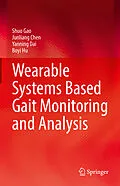Wearable Systems Based Gait Monitoring and Analysis provides a thorough overview of wearable gait monitoring techniques and their use in health analysis. The text starts with an examination of the relationship between the human body's physical condition and gait, and then introduces and explains nine mainstream sensing mechanisms, including piezoresistive, resistive, capacitive, piezoelectric, inductive, optical, air pressure, EMG, and IMU-based architectures. Gait sensor design considerations in terms of geometry and deployment are also introduced. Diverse processing algorithms for manipulating sensors outputs to transform raw data to understandable gait features are discussed. Furthermore, gait analysis-based health monitoring demonstrations are given at the end of this book, including both medical and occupational applications. The book will enable students of biomedical engineering, electrical engineering, signal processing, and ergonomics and practitioners to understand themedical and occupational applications of engineering-based gait analysis and falling injury prevention methods.
- Provides students and practitioners with an overview of wearable gait monitoring techniques;
- Includes detailed insole sensor design considerations;
- Features engineering-based gait analysis methods.
Autorentext
Jun-Liang Chen is a lead engineer at Smart Electronics Inc., Beijing, China. He received his bachelor's and master' degrees in engineering from Beihang University, Beijing, China. His research interests include piezoelectricity, circuit design, and signal processing and he has published more than 10 peer-reviewed research and review articles.
Yan-Ning Dai is a biomedical scientist at Smart Electronics Inc., Beijing, China. She received a bachelor's degree with a double major in instrumentation engineering and biomedical engineering and a master's degree in engineering from Beihang University, Beijing, China. Her research focuses on flexible electronics for human-machine interaction and health monitoring. She has published more than 20 peer-reviewed articles and patents.Boyi Hu, Ph.D., has been an assistant professor of industrial and systems engineering at the University of Florida since 2018. He received his Ph.D. degree from West Virginia University majoring in Ergonomics in 2016 and worked as a post-doc research fellow at Harvard T.H.Chan School of Public Health from 2016 to 2018. His research interests are ergonomics, biomechanics, system safety, and human-robot interaction. He has published over 40 peer-reviewed articles. As PI or Co-PI, his research has been funded by multiple US federal agencies, including the National Science Foundation, Department of Transportation, USDA National Institute of Food and Agriculture, and the National Institute for Occupational Safety and Health with the direct cost of over $4M in total. He has been serving as an associate editor for IEEE Transactions on Human-Machine Systems since 2020.Inhalt
Introduction.- Characteristics of Gait.- Wearable Gait Detection Technologies.- Gait Analysis Algorithms.- Medical Applications.- Occupational Applications. Conclusions.
